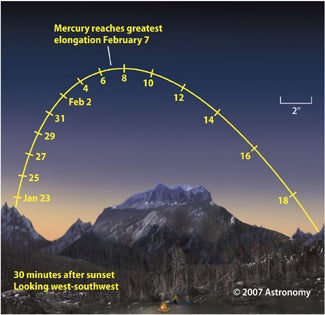
Mercury reaches the peak of this evening appearance February 7, when it lies farthest from the Sun and climbs highest in the twilight sky. It then appears about 10° – the approximate angle of your closed fist held at arm’s length – above the horizon 30 minutes after sunset. Mercury remains near this altitude for about a week on either side of the 7th.
Once you spot Mercury, you may wonder why it has a reputation for being elusive. It is, after all, one of the brightest objects in the sky. Unfortunately, this bright light never climbs high in the sky. Mercury orbits closer to the Sun than any other planet so, from our perspective on Earth, it never strays far from the Sun’s glare. Even at its best, the innermost planet lies low in the west shortly after sunset or low in the east before sunrise. It never gets far enough from the Sun to appear in a totally dark sky.
The great astronomer Nicolas Copernicus (1473-1543) – the man who put the Sun in its proper place at the center of the solar system, with Earth circling it – reportedly never glimpsed Mercury. So take a few minutes one of these chilly February evenings, and catch a sight a great astronomer missed.
February 2, 2007
WAUKESHA, WI – For those who like to spy night-sky treasures, late January and early February offer nice views of the solar system’s most elusive naked-eye planet. Mercury climbs into view in the west-southwest at the end of January, which appears as a pale-yellow dot low in the evening twilight.
Experts at your disposal
Astronomy magazine editors are available to discuss this event. To request an interview, please contact Matt Quandt at 262.798.6484 or mquandt@kalmbach.com.
Astronomy‘s mission:
Astronomy promotes the science and hobby of astronomy through high-quality publications that engage, inform, entertain, and inspire.
More resources from Astronomy magazine:
Astronomy news
This week’s sky events
Astronomy basics
Glossary of astronomical terms
Return to Astronomy “For the media” page
During the first 10 days of February, Mercury lies below and a little to the right of Venus. Although Venus gleams more than 10 times brighter than Mercury, you should be able to spot Mercury without much difficulty. If you don’t see Mercury right away, try finding it with binoculars. Once you know where it is, Mercury will pop into view.









